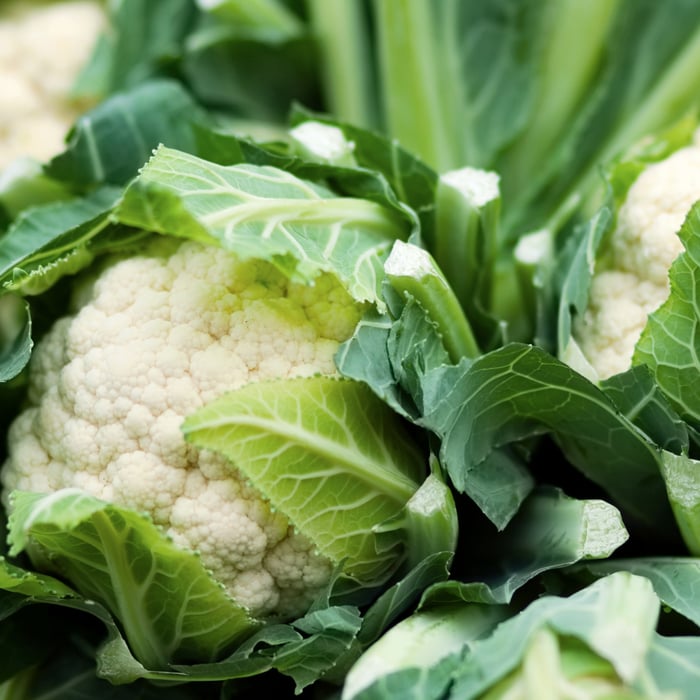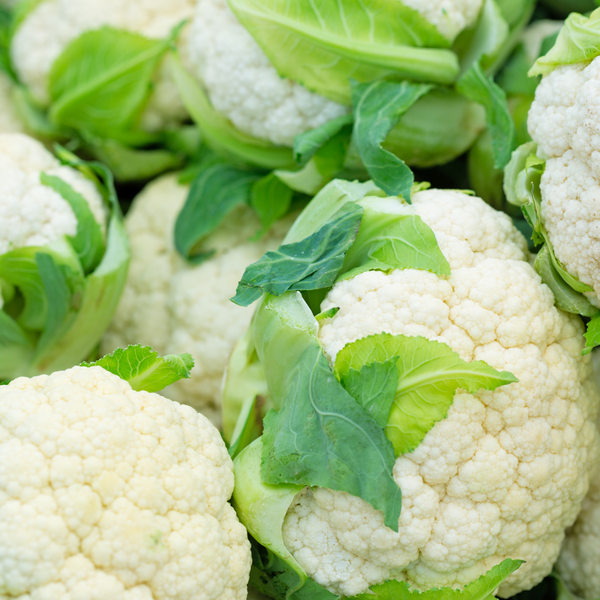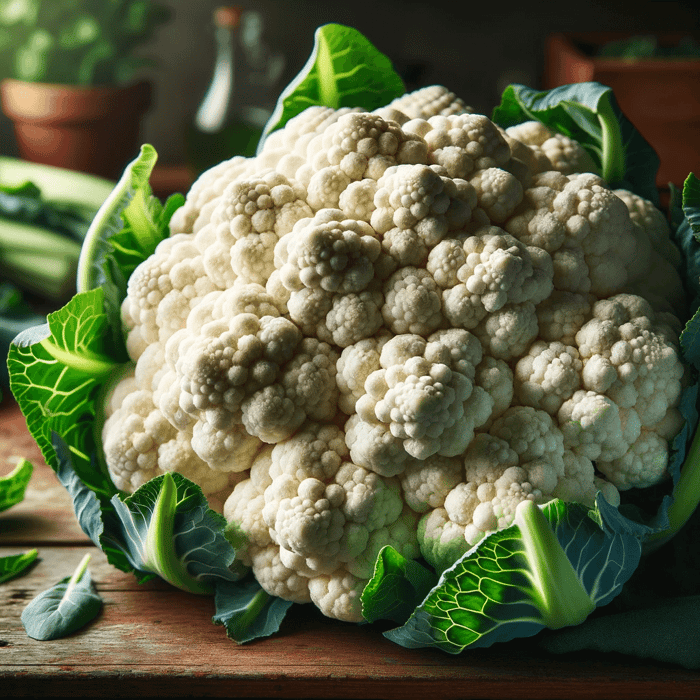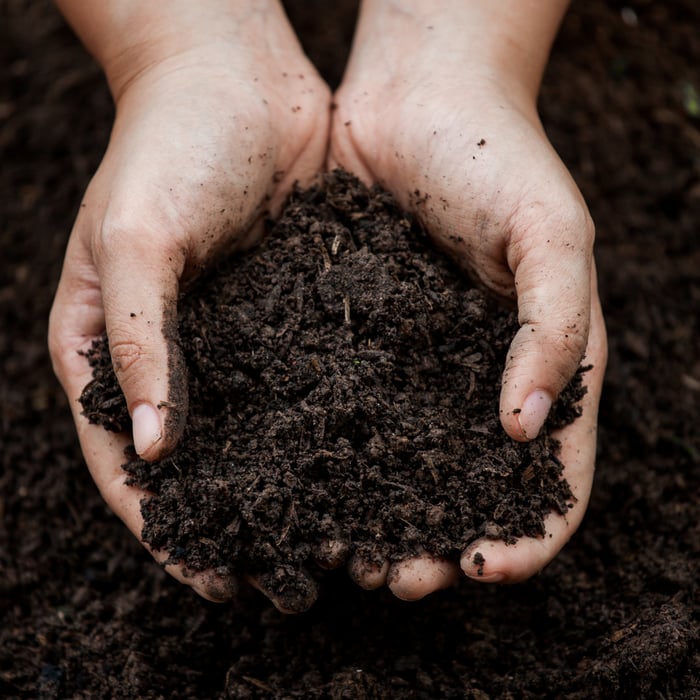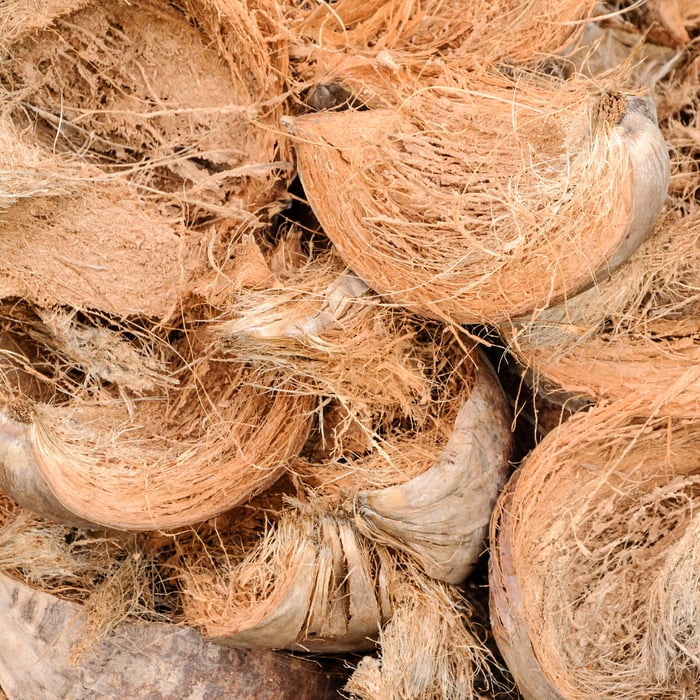Learning how to grow cauliflower from seed can seem super scary. This guide will hold your hand and walk you through how to grow cauliflower seeds all the way up to when it's time to harvest! Is cauliflower one of your favorite vegetables to grow?
How Long Does It Take for Cauliflower Seeds to Germinate?
Cauliflower is a popular cool-season crop that can be grown from seed. Like other seeds, cauliflower seeds need to germinate before they can grow into healthy plants. Germination is the process by which a seed sprouts and starts to grow roots and shoots. We'll explore how long it takes for cauliflower seeds to germinate and what factors can affect the germination process.
The length of time it takes for cauliflower seeds to germinate can vary depending on several factors, including the temperature, moisture level, and the quality of the seed. In general, cauliflower seeds will germinate within 5 to 10 days when the conditions are optimal. However, it may take up to 14 days or longer for the seeds to germinate under less ideal conditions.
Temperature is one of the most important factors that affect seed germination. Cauliflower seeds need a warm, moist environment to germinate properly. The ideal temperature range for cauliflower seed germination is between 60 and 70 degrees Fahrenheit. If the temperature is too low, the seeds may take longer to germinate, or they may not germinate at all.
The moisture level is another critical factor that affects seed germination. The soil needs to be kept moist but not too wet to prevent the seeds from rotting or developing fungal diseases. It's important to water the soil regularly but avoid overwatering.
The quality of the seed is also essential for successful germination. High-quality cauliflower seeds will have a high germination rate, which means that most of the seeds will sprout and grow into healthy plants. It's important to choose fresh, viable seeds from a reputable seed supplier to ensure the best germination results.
Snowball Y Improved Cauliflower Seeds
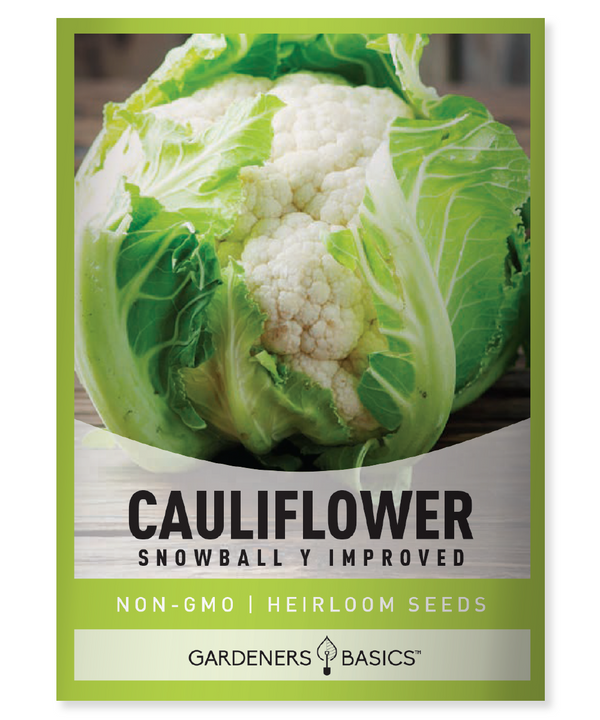
$2.49
Snowball Y Improved Cauliflower Seeds - Heirloom, Non-GMO, Non-Hybrid, Open-Pollinated Grow your own crisp and delicious Snowball Y Improved Cauliflower with our premium-quality seeds, perfect for gardeners who value heirloom, non-GMO, non-hybrid, and open-pollinated varieties. This early-maturing cauliflower produces smooth,… read more
To germinate cauliflower seeds, start by filling a seed tray or container with moist potting soil. Plant the seeds about 1/4 inch deep and cover them with a thin layer of soil. Keep the soil moist but not too wet and place the container in a warm, bright location.
Once the seeds start to germinate, they will develop into small seedlings. At this point, it's essential to provide the seedlings with enough light to grow properly. A grow light or a bright, sunny windowsill can provide enough light for the seedlings to thrive.
Cauliflower seeds typically germinate within 5 to 10 days under optimal conditions, but it can take longer under less ideal conditions. To ensure successful germination, it's important to provide the seeds with a warm, moist environment, high-quality soil, and enough light. With proper care, your cauliflower seeds will sprout and grow into healthy plants that will provide you with a delicious harvest.
What Is the Best Soil for Growing Cauliflower from Seed?
The soil is one of the most critical factors when it comes to knowing how to grow cauliflower from seed. The right soil composition can help the seeds germinate quickly and develop into healthy plants. We'll discuss what kind of soil is best for growing cauliflower from seed.
Cauliflower grows best in soil that is fertile, well-draining, and has a slightly acidic pH level between 6.0 and 7.0. The soil should be loose and crumbly, allowing for good airflow and water penetration. If the soil is too heavy, it may retain too much moisture, which can cause root rot and other diseases.
When preparing the soil for planting cauliflower seeds, it's important to amend it with organic matter such as compost, aged manure, or leaf mold. Organic matter helps to improve soil structure, retain moisture, and provide essential nutrients for plants. Mix in 2-3 inches of organic matter into the top 6 inches of soil.
Another essential component of soil for growing cauliflower from seed is nutrients. Cauliflower is a heavy feeder and requires a lot of nutrients to grow healthy and strong. A balanced fertilizer with equal amounts of nitrogen, phosphorus, and potassium can provide the necessary nutrients. A slow-release fertilizer can also be used to ensure that the plants receive a steady supply of nutrients throughout the growing season.
To avoid soil-borne diseases and pests, it's essential to use sterilized soil or soilless mix when starting cauliflower seeds indoors. Sterilized soil has been treated to kill any harmful microorganisms that may be present, reducing the risk of disease and pests. Soilless mix, on the other hand, is a mixture of peat moss, perlite, and vermiculite that provides a sterile and lightweight growing medium.
When transplanting cauliflower seedlings into the garden, it's important to prepare the soil by loosening it and removing any rocks or debris. Make sure the soil is moist but not too wet before planting the seedlings. Dig a hole that is deep enough to cover the root ball, and gently press the soil around the plant.
The best soil for growing cauliflower from seed is one that is fertile, well-draining, and has a slightly acidic pH level. Adding organic matter and using a balanced fertilizer can provide the necessary nutrients for the plants to grow healthy and strong. Using sterilized soil or soilless mix can help reduce the risk of disease and pests. With the right soil composition and proper care, your cauliflower seeds will grow into healthy plants that will provide you with a bountiful harvest.
When Is the Best Time to Start Cauliflower Seeds Indoors?
Starting cauliflower seeds indoors is an excellent way to get a head start on the growing season and ensure a healthy crop. However, timing is crucial when it comes to starting cauliflower seeds indoors. We'll explore when the best time to start cauliflower seeds indoors is and what factors to consider.
The best time to start cauliflower seeds indoors is about six to eight weeks before the last frost date in your area. This will give the seedlings enough time to grow and develop into healthy plants before transplanting them into the garden. The last frost date is the date when it's safe to plant tender plants outside without the risk of frost damage.
To determine the last frost date in your area, check with your local extension service or use an online tool. Once you have the last frost date, count back six to eight weeks to determine the best time to start your cauliflower seeds indoors.
Temperature is another critical factor to consider when starting cauliflower seeds indoors. The ideal temperature for cauliflower seed germination is between 60 and 70 degrees Fahrenheit. Once the seeds have germinated, they will require slightly cooler temperatures between 50 and 60 degrees Fahrenheit to grow properly.
To start cauliflower seeds indoors, fill a seed tray or container with a high-quality seed-starting mix. Plant the seeds about 1/4 inch deep and cover them with a thin layer of soil. Keep the soil moist but not too wet and place the container in a warm, bright location.
Once the seeds have germinated and developed into seedlings, it's important to provide them with enough light to grow properly. A grow light or a bright, sunny windowsill can provide enough light for the seedlings to thrive. Make sure to keep the seedlings well-watered and fertilize them regularly with a balanced fertilizer.
When the seedlings have grown to about 2-3 inches tall and have developed a few true leaves, they are ready to be transplanted into the garden. Before transplanting, harden off the seedlings by gradually exposing them to outdoor conditions over a period of 7-10 days. This will help the plants adjust to the change in temperature and reduce the risk of transplant shock.
The best time to start cauliflower seeds indoors is about six to eight weeks before the last frost date in your area. Temperature is also an essential factor to consider when starting cauliflower seeds indoors. Make sure to provide the seedlings with enough light and water and fertilize them regularly. With proper care, your cauliflower seedlings will grow into healthy plants that will provide you with a bountiful harvest.
How Often Should I Water Cauliflower Seedlings?
Water is essential for the growth and development of all plants, including cauliflower seedlings. However, it's important to water cauliflower seedlings correctly to ensure healthy growth and prevent overwatering. We'll explore how often you should water cauliflower seedlings and what factors to consider.
The frequency of watering cauliflower seedlings depends on several factors, including temperature, humidity, and soil type. In general, it's best to water cauliflower seedlings when the top inch of soil is dry to the touch. This will ensure that the plants are getting enough water without drowning their roots.
During the germination stage, it's important to keep the soil moist but not too wet. Overwatering can lead to fungal diseases and root rot, which can stunt the growth of the seedlings or kill them. To avoid overwatering, water the seedlings lightly and avoid getting water on the leaves, as this can lead to fungal diseases.
Once the cauliflower seedlings have developed into small plants, they will require more water. In general, it's best to water the plants deeply once or twice a week, depending on the weather conditions. If it's hot and dry, the plants may require more frequent watering to prevent them from wilting.
When watering cauliflower seedlings, it's important to water the soil around the base of the plant rather than the leaves. Watering the leaves can increase the risk of fungal diseases, as the moisture can get trapped in between the leaves.
Another important factor to consider when watering cauliflower seedlings is the soil type. If the soil is heavy and clay-like, it may retain too much moisture, which can lead to root rot. In this case, it's important to water the plants less frequently and ensure that the soil has good drainage. If the soil is sandy, it may require more frequent watering, as it tends to dry out quickly.
To check the moisture level of the soil, stick your finger about an inch deep into the soil. If the soil feels dry, it's time to water the plants. If it feels moist, wait a day or two before watering again.
The frequency of watering cauliflower seedlings depends on several factors, including temperature, humidity, and soil type. In general, it's best to water the plants when the top inch of soil is dry to the touch. Avoid overwatering and water the soil around the base of the plant rather than the leaves. With proper watering, your cauliflower seedlings will grow into healthy plants that will provide you with a bountiful harvest.
Vegetable Seed Vault Kit | 35 Variety Pack

$29.95
$49.95
Ultimate Survival Seed Vault: 16,000+ Non-GMO Heirloom Vegetable Seeds for Emergency Preparedness Introducing the Seed Vault Kit, your all-in-one solution for emergency preparedness and sustainable gardening. This premium seed kit contains over 16,000 non-GMO, Heirloom, Non-Hybrid, and Open Pollinated seeds,… read more
How Do I Transplant Cauliflower Seedlings into the Garden?
Transplanting cauliflower seedlings from indoors to the garden is an exciting and crucial step in the growing process. However, it's essential to transplant the seedlings correctly to ensure their survival and healthy growth. We'll explore how to transplant cauliflower seedlings into the garden and what factors to consider.
Before transplanting cauliflower seedlings into the garden, it's important to harden them off gradually. Hardening off is the process of gradually exposing the seedlings to outdoor conditions over a period of 7-10 days. This will help the plants adjust to the change in temperature and reduce the risk of transplant shock.
To harden off cauliflower seedlings, start by placing them outside in a sheltered area for a few hours each day, gradually increasing the time over the course of a week. Make sure to protect the seedlings from strong winds, direct sunlight, and extreme temperatures.
When the cauliflower seedlings are ready to be transplanted, choose a sunny location in the garden with well-draining soil. The soil should be fertile and slightly acidic, with a pH level between 6.0 and 7.0. Avoid planting cauliflower in soil that has recently had brassica crops or other members of the cabbage family, as this can increase the risk of disease.
Dig a hole that is slightly larger than the root ball of the seedling. Gently remove the seedling from its container, being careful not to damage the delicate roots. Place the seedling in the hole and backfill it with soil, making sure to cover the roots completely.
Water the transplanted seedlings deeply, making sure that the soil is moist but not too wet. Avoid getting water on the leaves, as this can increase the risk of fungal diseases.
It's essential to provide the transplanted cauliflower seedlings with enough space to grow. Space the plants about 18 to 24 inches apart, depending on the variety. This will give them enough room to grow and prevent overcrowding, which can lead to poor air circulation and an increased risk of disease.
Once the cauliflower plants have been transplanted into the garden, it's important to provide them with proper care. Water the plants deeply once or twice a week, depending on the weather conditions. Fertilize the plants regularly with a balanced fertilizer to ensure that they receive the necessary nutrients.
Cauliflower plants are susceptible to pests and diseases, so it's important to keep an eye out for any signs of trouble. Common pests include aphids, cabbage loopers, and cabbage worms. To prevent pest infestations, remove any weeds or debris from the garden and cover the plants with row covers.
Transplanting cauliflower seedlings into the garden is an exciting and crucial step in the growing process. Harden off the seedlings gradually before transplanting them and choose a sunny location with well-draining soil. Make sure to provide the transplanted seedlings with enough space to grow and water and fertilize them regularly. Keep an eye out for pests and diseases and take steps to prevent infestations. With proper care, your cauliflower plants will grow into healthy plants that will provide you with a delicious harvest.
How to Fertilize Cauliflower Plants for Maximum Yield?
Fertilizing cauliflower plants is essential to ensure healthy growth and maximum yield. However, it's important to choose the right fertilizer and apply it correctly to avoid over-fertilizing or under-fertilizing. We'll explore how to fertilize cauliflower plants for maximum yield.
Cauliflower is a heavy feeder and requires a lot of nutrients to grow healthy and strong. A balanced fertilizer with equal amounts of nitrogen, phosphorus, and potassium can provide the necessary nutrients for the plants. A slow-release fertilizer can also be used to ensure that the plants receive a steady supply of nutrients throughout the growing season.
Before planting cauliflower seeds or transplanting seedlings, it's important to amend the soil with organic matter such as compost, aged manure, or leaf mold. This will help improve soil structure, retain moisture, and provide essential nutrients for the plants.
Once the plants have been established, it's time to start fertilizing. Apply a balanced fertilizer, such as a 10-10-10 or 20-20-20 fertilizer, every four to six weeks throughout the growing season. Follow the instructions on the fertilizer package for the correct application rate.
It's important not to over-fertilize cauliflower plants, as this can lead to excessive leaf growth and poor-quality heads. Over-fertilization can also lead to environmental problems, such as nitrogen leaching into groundwater and causing pollution.
To avoid over-fertilization, it's essential to apply the fertilizer evenly and at the correct rate. Use a broadcast spreader or hand spreader to distribute the fertilizer evenly over the soil surface. Water the plants after applying the fertilizer to help dissolve the nutrients and move them down into the soil.
In addition to fertilizing, it's important to keep the soil moist but not too wet. Overwatering can leach nutrients out of the soil, making them unavailable to the plants. Underwatering can also lead to nutrient deficiencies and poor growth.
It's also essential to monitor the plants for any signs of nutrient deficiencies. Common symptoms of nutrient deficiencies include yellowing leaves, stunted growth, and poor-quality heads. If you notice any of these symptoms, apply a foliar fertilizer or a quick-release fertilizer to correct the problem.
Fertilizing cauliflower plants is essential to ensure healthy growth and maximum yield. Choose a balanced fertilizer with equal amounts of nitrogen, phosphorus, and potassium, and apply it every four to six weeks throughout the growing season. Amend the soil with organic matter before planting or transplanting, and apply the fertilizer evenly and at the correct rate. Keep the soil moist but not too wet, and monitor the plants for any signs of nutrient deficiencies. With proper fertilization, your cauliflower plants will grow into healthy plants that will provide you with a bountiful harvest.
How to Harvest Cauliflower for Maximum Flavor and Nutrition?
Harvesting cauliflower at the right time is essential to ensure maximum flavor and nutrition. Harvesting too early can result in small heads with a bitter taste while harvesting too late can lead to heads that are overripe and tough. We'll explore how to harvest cauliflower for maximum flavor and nutrition.
Cauliflower heads are ready to harvest when they reach full size and are still compact and firm. The size of the head will depend on the variety, but in general, it should be about six to eight inches in diameter. The color of the head should be creamy white or light green, depending on the variety.
To harvest cauliflower, use a sharp knife to cut the head from the stem, leaving a few leaves attached to the head. Make the cut as close to the base of the head as possible, being careful not to damage the surrounding leaves or other plants.
Once the cauliflower head has been harvested, it's important to store it properly to maintain its freshness and flavor. Store the head in the refrigerator, wrapped in plastic or a damp towel, for up to a week. Do not wash the head before storing it, as this can cause it to spoil more quickly.
Cauliflower is a nutritious vegetable that is rich in vitamins, minerals, and antioxidants. To maximize the nutritional value of cauliflower, it's important to cook it correctly. Avoid overcooking cauliflower, as this can lead to a loss of nutrients and flavor. Instead, steam or sauté the cauliflower lightly to preserve its nutritional value.
Cauliflower can also be eaten raw in salads or as a crunchy snack. To prepare cauliflower for raw consumption, wash the head thoroughly and cut it into small florets. Serve with a healthy dip, such as hummus or yogurt, for added flavor and nutrition.
In addition to the head, the leaves of the cauliflower plant can also be eaten. Cauliflower leaves are a good source of fiber, vitamins, and minerals. To prepare cauliflower leaves, wash them thoroughly and sauté them lightly with garlic and olive oil.
Harvesting cauliflower at the right time is essential to ensure maximum flavor and nutrition. Harvest the head when it is full size, compact, and firm, and store it properly to maintain its freshness and flavor. Cook cauliflower lightly to preserve its nutritional value, or eat it raw for a crunchy snack. Don't forget to try the leaves as well for added nutrition and flavor. With proper harvesting and preparation, your cauliflower will provide you with a delicious and nutritious addition to your meals.
Seed Safe Survival Seed Kit - 35 Variety Pack
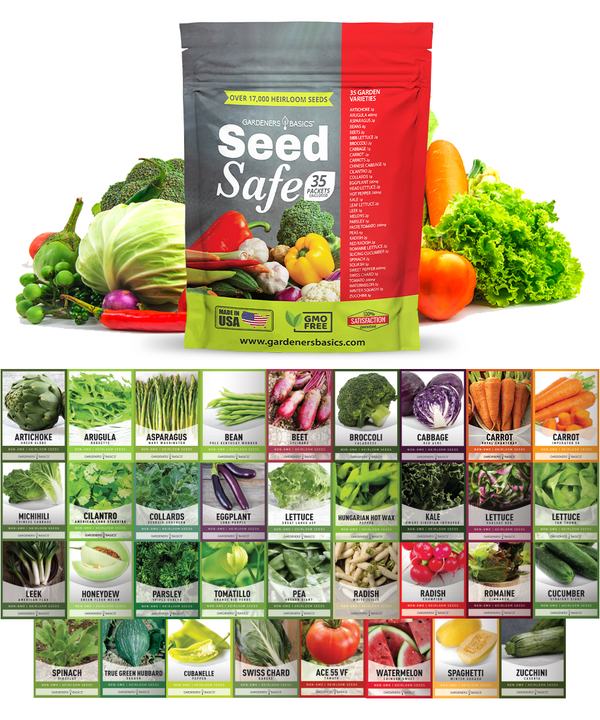
$29.95
$49.95
Seed Safe Survival Seed Kit: The Ultimate Heirloom Collection for Self-Sufficient Gardening Introducing the Seed Safe - 35 Varieties of Heirloom Vegetable, Herb, and Fruit Seeds, the ultimate solution for gardeners who want to secure a bountiful future harvest. This… read more
How to Control Pests on Cauliflower Plants Naturally?
Cauliflower plants are susceptible to a variety of pests, including aphids, cabbage loopers, and cabbage worms. These pests can cause damage to the plants and reduce their yield. However, it's possible to control pests on cauliflower plants naturally without resorting to chemical pesticides. We'll explore how to control pests on cauliflower plants naturally so you can efficiently learn how to grow cauliflower from seed.
One of the most effective ways to control pests on cauliflower plants is to encourage natural predators. Ladybugs, lacewings, and parasitic wasps are all-natural predators that can help keep pest populations under control. To attract these predators to your garden, plant a variety of flowers, herbs, and plants that provide food and shelter for them.
Another natural way to control pests on cauliflower plants is to use row covers. Row covers are lightweight fabrics that are placed over the plants to protect them from pests and other environmental factors. Row covers can also help regulate temperature and humidity, which can improve plant growth.
To control aphids on cauliflower plants, try using a homemade insecticidal soap. Mix one teaspoon of dish soap with one quart of water and spray the solution onto the plants, making sure to coat both the tops and bottoms of the leaves. The soap will kill the aphids by suffocating them, but it won't harm beneficial insects.
To control cabbage loopers and cabbage worms, try using a biological insecticide called Bacillus thuringiensis (Bt). Bt is a naturally occurring bacterium that kills the larvae of these pests. To use Bt, mix it with water according to the package instructions and spray it onto the plants, making sure to coat both the tops and bottoms of the leaves.
Another natural way to control pests on cauliflower plants is to handpick them off the plants. This method can be time-consuming, but it's effective for small pest populations. Wear gloves to protect your hands and use a small brush to gently remove the pests from the leaves.
It's also important to practice good garden hygiene to prevent pest infestations. Remove any debris or weeds from the garden, as these can harbor pests and diseases. Rotate crops each year to prevent the buildup of pests and diseases in the soil.
Controlling pests on cauliflower plants naturally is possible with a combination of methods. Encourage natural predators, use row covers, and try homemade insecticidal soap or biological insecticides. Handpicking pests off the plants and practicing good garden hygiene can also help prevent pest infestations. With proper pest control, your cauliflower plants will grow into healthy plants that will provide you with a bountiful harvest.
How to Water Cauliflower Plants for Maximum Growth and Yield?
Watering cauliflower plants is essential to ensure maximum growth and yield. However, it's important to water the plants correctly to avoid overwatering or under-watering. We'll explore how to water cauliflower plants for maximum growth and yield when learning how to grow cauliflower from seed.
Cauliflower plants require consistent moisture throughout the growing season. However, they are also susceptible to root rot if the soil is too wet. To avoid overwatering, it's important to water the plants deeply but infrequently.
Water the plants deeply once or twice a week, depending on the weather conditions. Use a soaker hose or drip irrigation system to deliver the water directly to the soil, avoiding getting the leaves wet. Water the plants in the morning or early evening to reduce water loss due to evaporation.
It's also important to monitor the soil moisture level regularly. Stick your finger into the soil to a depth of one to two inches. If the soil feels dry at this depth, it's time to water the plants. If the soil feels moist, wait a day or two before checking again.
In addition to watering the plants, it's important to mulch around the plants to help retain soil moisture. Mulching can also help regulate soil temperature and suppress weed growth. Use a layer of organic mulch, such as straw, leaves, or grass clippings, around the base of the plants.
If you live in an area with dry or arid conditions, consider using a water-retention product to help keep the soil moist. Water-retention products, such as hydrogel crystals, absorb and hold onto water, releasing it slowly over time.
It's also important to avoid overhead watering, as this can increase the risk of fungal diseases. Instead, use a soaker hose or drip irrigation system to deliver the water directly to the soil.
Watering cauliflower plants correctly is essential to ensure maximum growth and yield. Water the plants deeply but infrequently, and use a soaker hose or drip irrigation system to deliver the water directly to the soil. Monitor the soil moisture level regularly and mulch around the plants to help retain soil moisture. Consider using a water-retention product in dry or arid conditions. With proper watering, your cauliflower plants will grow into healthy plants that will provide you with a bountiful harvest. Great! Let's move on to the tenth and final keyword from the list, "companion planting," and write a 1000-word article about it.
Companion Planting for Cauliflower: What Plants to Grow with Cauliflower for Maximum Yield?
Companion planting is the practice of growing different plants together to improve growth, yield, and pest resistance. When it comes to cauliflower, certain plants can be grown as companions to improve its growth and yield. Let us explore what plants to grow with cauliflower for maximum yield.
One of the best companion plants for cauliflower is celery. Celery and cauliflower are both heavy feeders and require similar nutrients. Celery can also help repel pests such as aphids and whiteflies, which can damage cauliflower plants.
Another good companion plant for cauliflower is dill. Dill can attract beneficial insects such as ladybugs and lacewings, which can help control pest populations on the cauliflower plants. Dill can also help improve the flavor of the cauliflower heads.
Carrots are another good companion plant for cauliflower. Carrots and cauliflower have different root depths and can grow together without competing for nutrients. Carrots can also help improve soil structure and reduce soil-borne diseases, which can benefit cauliflower plants.
Lettuce is another good companion plant for cauliflower. Lettuce can help shade cauliflower plants and retain soil moisture. Lettuce can also be harvested before the cauliflower heads mature, allowing the cauliflower plants to have more space and nutrients.
In addition to these plants, herbs such as thyme and sage can also be grown as companions to cauliflower. Thyme and sage can help repel pests and improve the flavor of the cauliflower heads.
However, there are also plants that should not be grown with cauliflower as they can compete for nutrients or attract pests. Brassica family plants, such as broccoli, kale, and Brussels sprouts, should not be grown with cauliflower as they require similar nutrients and can compete with cauliflower plants. Tomatoes, peppers, and eggplants should also be avoided as they can attract pests such as aphids and whiteflies.
Companion planting is an effective way to improve the growth and yield of cauliflower plants. Growing celery, dill, carrots, lettuce, thyme, and sage as companions can help repel pests, improve soil structure, and enhance the flavor of the cauliflower heads. However, it's important to avoid growing competing plants or plants that can attract pests. With proper companion planting, your cauliflower plants will grow into healthy plants that will provide you with a bountiful harvest.
Conclusion
Growing cauliflower doesn't have to be hard or scary. Just follow the easy steps above and get to growing your cauliflower today. Now that you know how to grow cauliflower from seed, are you going to give it a try this year? Cauliflower has had a couple of crop failures in the past few years. Make sure to grab your cauliflower seeds when you see them for sale.
Frequently Asked Questions (FAQs)-
Can I grow cauliflower in containers?
-
How often should I fertilize my cauliflower plants?
-
How do I prevent pests from attacking my cauliflower plants?
-
When is the best time to harvest cauliflower?
-
Can I eat the leaves of the cauliflower plant?
-
How often should I water my cauliflower plants?



